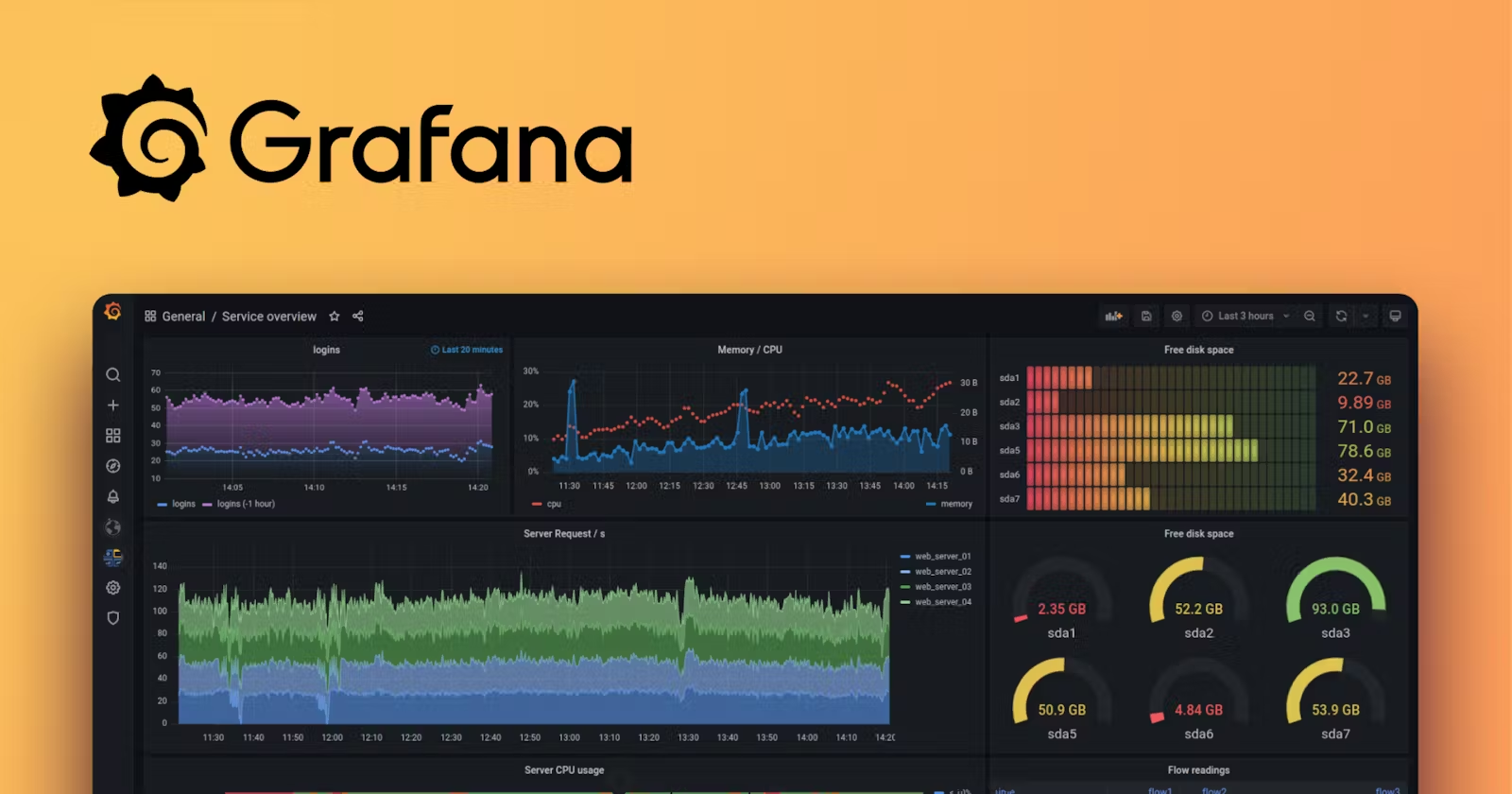Grafana
 Ashwin
Ashwin
In the real time of monitoring and observability, Grafana has emerged as a powerful and versatile tool, empowering users to gain insights through intuitive visualizations. In this blog post, we'll delve into what Grafana is, its key features, why it's preferred, the types of monitoring it facilitates, compatible databases, and the nuances between Grafana and Prometheus. Additionally, we'll provide step-by-step instructions on setting up Grafana on a Linux system.
What is Grafana?
Grafana is an open-source analytics and monitoring platform designed to visualize and analyze metrics from various data sources. It provides a centralized platform for creating, exploring, and sharing dashboards, enabling users to gain a holistic view of their system's performance and health.
Key Features of Grafana:
1. Extensive Data Source Support:
Grafana supports a wide range of data sources, including popular databases like Prometheus, InfluxDB, Elasticsearch, and more. This flexibility allows users to consolidate and visualize metrics from various systems within a unified dashboard.
2. Intuitive Dashboards:
With a user-friendly interface, Grafana facilitates the creation of customizable dashboards. Users can choose from a variety of panels and charts to represent data in a way that suits their specific monitoring needs.
3. Alerting and Notifications:
Grafana provides robust alerting capabilities, allowing users to set up alerts based on specific conditions. Notifications can be sent via various channels, ensuring that critical issues are promptly addressed.
4. Community and Plugin Support:
A vibrant community and a vast repository of plugins contribute to Grafana's extensibility. Users can enhance functionality by integrating plugins for additional data sources, visualizations, and alerting mechanisms.
Why Choose Grafana?
The appeal of Grafana lies in its versatility and adaptability. It caters to a broad spectrum of use cases, from infrastructure monitoring to business intelligence. Its open-source nature, coupled with an active community, ensures continuous improvement and the availability of valuable resources.
Monitoring with Grafana:
Grafana facilitates various monitoring types, including:
1. Infrastructure Monitoring:
Track the health and performance of servers, networks, and other infrastructure components.
2. Application Monitoring:
Monitor application metrics, logs, and traces to identify bottlenecks and optimize performance.
3. Business Metrics:
Visualize business-related metrics, helping organizations make data-driven decisions.
Databases Compatible with Grafana:
Grafana seamlessly integrates with databases like:
Prometheus
InfluxDB
Graphite
Elasticsearch
MySQL
PostgreSQL, and more.
Metrics and Visualizations:
Metrics represent quantifiable data points, while visualizations in Grafana transform these metrics into meaningful charts and graphs. Grafana supports a variety of visual elements, including line graphs, bar charts, heatmaps, and more, providing a comprehensive view of data trends.
Grafana vs. Prometheus:
While Grafana and Prometheus often work together, they serve distinct purposes. Prometheus is primarily a monitoring and alerting toolkit, while Grafana is an analytics and visualization platform. Prometheus collects and stores metrics, and Grafana pulls these metrics to create insightful dashboards.
Setting Up Grafana:
Now, let's walk through the steps to set up Grafana on a Linux system:
- Install prerequisite packages:
sudo apt-get install -y apt-transport-https software-properties-common wget
- Import the GPG key:
sudo mkdir -p /etc/apt/keyrings/
wget -q -O - https://apt.grafana.com/gpg.key | gpg --dearmor | sudo tee /etc/apt/keyrings/grafana.gpg > /dev/null
- Add a repository for stable releases:
echo "deb [signed-by=/etc/apt/keyrings/grafana.gpg] https://apt.grafana.com stable main" | sudo tee -a /etc/apt/sources.list.d/grafana.list
- Update the list of available packages:
sudo apt-get update
- Install Grafana OSS:
sudo apt-get install grafana
- Enable and start Grafana service:
sudo systemctl enable grafana-server
sudo systemctl start grafana-server
- Check the status:
sudo systemctl status grafana-server
Now launch Grafana by going to <ipaddress>:3000 in your browser. Make sure port 3000 is open in the ec2 instance security group.

Interview Questions
1. What is the Architecture of Prometheus Monitoring?

Prometheus follows a unique and powerful architecture designed for scalability and flexibility. At its core, Prometheus adopts a server-client model. The main components include:
Prometheus Server: This is the central component responsible for collecting and storing time-series data through HTTP pull requests. It also processes alerts, rules, and triggers notifications when necessary.
Prometheus Storage: The storage engine is a critical part of Prometheus, managing time-series data efficiently. It utilizes a custom, compressed format for storing data on disk.
Prometheus Pushgateway: This optional component allows ephemeral and batch jobs to push their metrics to Prometheus. It simplifies integration for jobs that are not long-lived or may have short lifespans.
Prometheus Alertmanager: This module handles alerts sent by the Prometheus server, deduplicates, groups, and routes them to the correct receiver (like email, Slack, etc.).
Instrumented Applications: Prometheus works by pulling metrics from instrumented applications, which expose endpoints for Prometheus to scrape.
2. What are the Features of Prometheus?
Prometheus boasts an array of features that contribute to its popularity in the monitoring landscape:
Multi-dimensional Data Model: Prometheus embraces a multi-dimensional data model, allowing efficient storage and querying of time-series data, which is crucial for monitoring diverse systems.
PromQL: A powerful query language that enables users to perform complex queries on collected data, facilitating advanced analysis and troubleshooting.
Alerting: Prometheus supports a robust alerting system, providing real-time notifications based on predefined rules and thresholds.
Scalability: Its architecture supports horizontal scalability, making it suitable for small setups to large, complex environments.
Service Discovery: Prometheus easily integrates with service discovery mechanisms, allowing dynamic monitoring of changing infrastructures.
3. What are the Components of Prometheus?
Prometheus comprises several components that work seamlessly together:
Prometheus Server
Prometheus Storage
Prometheus Pushgateway
Prometheus Alertmanager
Client Libraries: These libraries are available in various languages, and they allow applications to expose metrics for Prometheus to scrape.
4. What database is used by Prometheus?
Prometheus relies on a custom time-series database that efficiently stores and retrieves metrics data. This database is specifically designed for the unique needs of Prometheus, ensuring optimal performance and scalability for time-series data.
5. What is the default data retention period in Prometheus?
The default data retention period in Prometheus is 15 days. However, this can be customized based on the specific requirements of the monitoring environment.
Conclusion
Grafana is a powerful, adaptable monitoring solution with a user-friendly interface and broad data source support. Its seamless integration with popular databases simplifies infrastructure and application monitoring. The straightforward installation guide enables users to quickly harness Grafana's capabilities to create insightful dashboards.
Subscribe to my newsletter
Read articles from Ashwin directly inside your inbox. Subscribe to the newsletter, and don't miss out.
Written by

Ashwin
Ashwin
I'm a DevOps magician, conjuring automation spells and banishing manual headaches. With Jenkins, Docker, and Kubernetes in my toolkit, I turn deployment chaos into a comedy show. Let's sprinkle some DevOps magic and watch the sparks fly!